Plumerias are so exotic and beautiful that it seems like they would be difficult to care for. But they’re actually quite easy to grow once you learn how.
In this post, I’ll tell you all you need to know about how to grow plumerias, including water, soil, fertilizer, and light, as well as tips one propagating, pruning, flowering, and more.
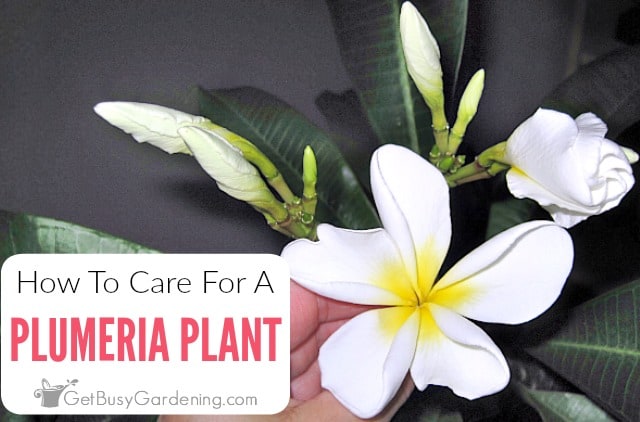
When I think back to my trips to Hawaii, one thing that I remember the most was all of the gorgeous plumerias growing and blooming everywhere.
So of course, I absolutely had to bring one home with me when I went back to Minnesota.
My new baby Hawaiian lai plant was only about a foot tall when I got it, and it bloomed shortly after I brought it home.
I instantly feel in love, and was pleasantly surprised by how low maintenance it was. If you want to try one for yourself, then you’re in the right place.
Below I’ll tell you everything you need to know about their care, and show you how to grow plumeria no matter where you live.
Plumeria Quick Care Overview
| Scientific name: | Plumeria |
| Classification: | Tropical plant |
| Common names: | Frangipani, Hawaiian Lei Plant, Kalachuchi, Champa Flower |
| Hardiness: | Zones 10+ |
| Temperature: | 60-75°F |
| Flowers: | Colors and bloom times vary by species |
| Light: | Full to partial shade, bright light indoors |
| Water: | Allow soil to dry slightly, do not overwater |
| Humidity: | Moderate to low |
| Fertilizer: | Flowering plant food in spring and summer |
| Soil: | Fast-draining, fertile soil |
| Common pests: | Spider mites, whiteflies |
Information About Plumerias
Plumerias are popular tropical plants that can grow into huge trees in their native environment.
You might know them better as a Hawaiian Lei Plant (plumerias are the type of flowers traditionally used to make leis), or maybe by their less common name, Frangipani.
But don’t let their common name fool you, they aren’t actually native to Hawaii. They’re originally from the tropical regions in Central and South America, as well as parts of the Caribbean.
Different Types Of Plumeria
There are several different varieties of plumerias, some can become large trees, while others are smaller shrubs. But they all require the same care and attention. Here are a few of the most common.
- Plumeria pudica – Also known as Bridal Bouquet because of the white flowers, this is one of the hardier varieties that can survive down to zone 9. It can reach 15-20′ tall.
- Plumeria rubra – This is one of the more common types, and there are several hybrids. Depending on the cultivar, they can grow anywhere from 6-30′. The flowers come in just about any color too, and some can bloom year round.
- Plumeria obtusa – There are a few cultivars of this one too, many of which are shorter dwarf varieties. Colors and bloom times also vary between them.
- Plumeria alba – Sometimes commonly called a Nosegay Tree, this species is another one that can grow 6-30′ in height.
Flowers
As I’m sure you probably already know, plumeria is prized for their gorgeous, and highly fragrant flowers.
Depending on the species, they can be just about any color, and some individual blossoms even contain more than one.
The time of year totally depends on the variety. Some only flower in late winter through spring or summer, while others will bloom profusely all year long.

Toxicity
The sap can cause irritation for those with sensitive skin, and is also toxic to cats, dogs, and people if ingested.
Though they’re only mildly poisonous, it’s best to keep them out of reach of your kids and pets if this is a concern for you. The ASPCA website is a great source for more information.
How To Grow Plumeria
Before we jump into the details of plumeria plant care, first we should chat about where to grow them. Choosing the right location is key to long-lasting, sustained health.
Hardiness
Most frangipani plants can only live outdoors in zones 10 or higher, though there are few that can survive down to zone 9.
They’re very sensitive to the cold, and will drop their leaves or turn yellow or brown in the fall, even in warmer areas.
Where To Grow Plumeria Plants
In warm enough climates, plumerias can grow into very large trees, so they will need a lot of space in your yard.
If you want to restrict their size, you can put them in a container instead of in the ground, they do very in pots.
They can also thrive indoors in a spot with plenty of light. Although it’s very uncommon for them to bloom inside the house.
For that reason, I find it’s much easier to put them outside in the summer to maintain their health and growth, and also encourage flowering.

Plumeria Plant Care & Growing Instructions
With the proper care, plumerias can live for many years. Now that you know where to plant them, let’s chat about their needs. Follow these tips to keep your plumeria growing and blooming year after year.
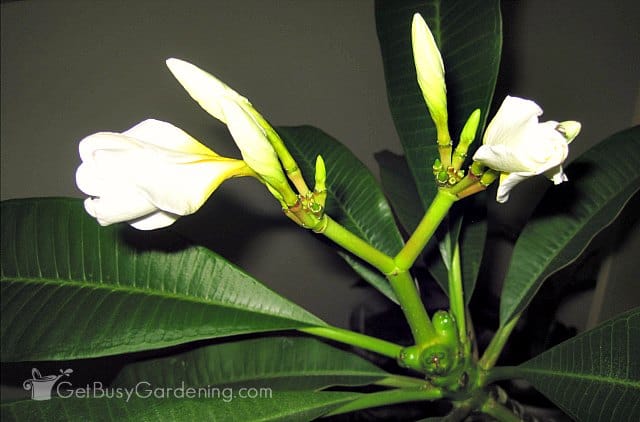
Watering Requirements
Plumerias like a lot of water, but won’t tolerate being overwatered. When they’re too wet, the trunk will rot, and it will eventually kill the plant.
It’s kind of a funny combination, give it a lot of water… but don’t overwater? I know, but don’t worry it’s actually pretty easy. A moisture gauge will help you get it right.
During the summer months, give it a really good, deep drink. Allow the excess to drain completely, and wait until it’s mostly dry before adding more.
Since they go dormant during the winter, it’s best to water them very sparingly, if at all, during those months.
Humidity
You might be surprised to learn that plumeria plants prefer moderate to low humidity levels.
If it’s extremely dry in your home, you can place a humidifier next to it to help add extra moisture to the air.
However, be careful misting or spraying them with water, you don’t want to overdo it. If droplets are constantly sitting on the branches or leaves, it could cause them to rot.
Light Requirements
Plumerias need full sun in order to grow their best and also to bloom, otherwise they will become sparse and leggy.
If yours is outside, put it in a full sun location. Otherwise if it’s indoors year round, then you’ll likely need to get a grow light.
When you move it outside for the summer, don’t give it full exposure right away, or it could burn. Instead, put it in the shade for a few days, and gradually introduce it to a full sun location.
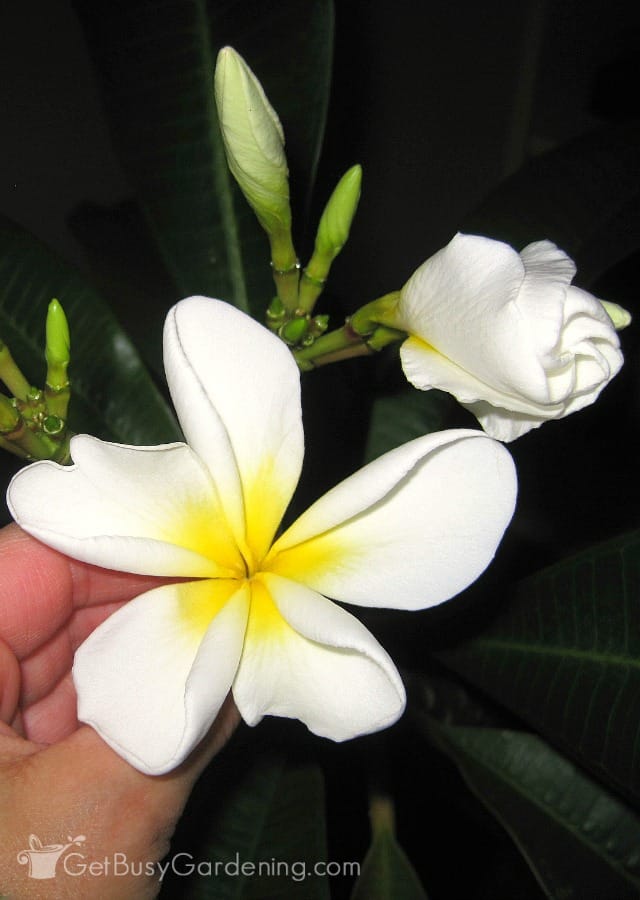
Temperature
Plumerias are not cold hardy plants. Their ideal temperature range is between 60-75°F.
If it gets much colder, they’ll start dropping their leaves, and below freezing temps will quickly kill them. Even a light frost can damage the tender branch tips.
Hotter weather doesn’t often bother them, though the high heat in arid climates will dry them out too quickly.
Best Soil
The best soil for successful plumeria plant care is a fast draining mix that’s slightly acidic, ranging between 6-7 on a pH meter.
You don’t necessarily need to buy any special type, and you can even make your own if you want.
I grow mine in a homemade mixture of 2 parts general purpose soil with 1 part each of either perlite or pumice, and sand.
Find out more about how to choose the best soil for your plumeria, including my recipe to make your own in my detailed guide.
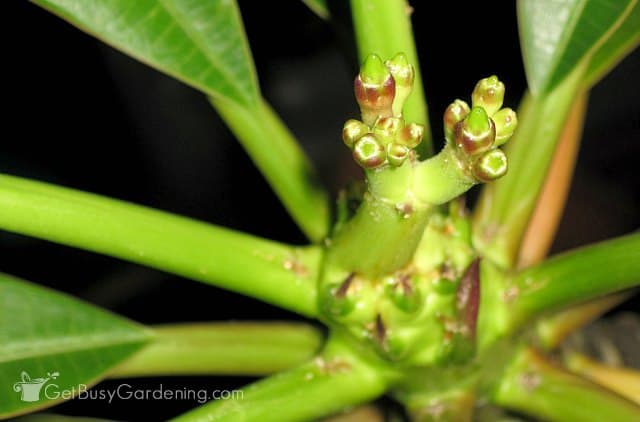
Fertilizer
As I already mentioned, plumerias are very heavy feeders, and fertilizing is an important part of their care.
They need a type that is high in phosphorus in order to bloom. Apply an organic liquid flower food every 1-3 weeks in the spring and summer. You can also apply granules monthly to provide even more nutrients.
Fertilize them from spring through summer, and stop in early fall. Then don’t feed them at all during the winter.
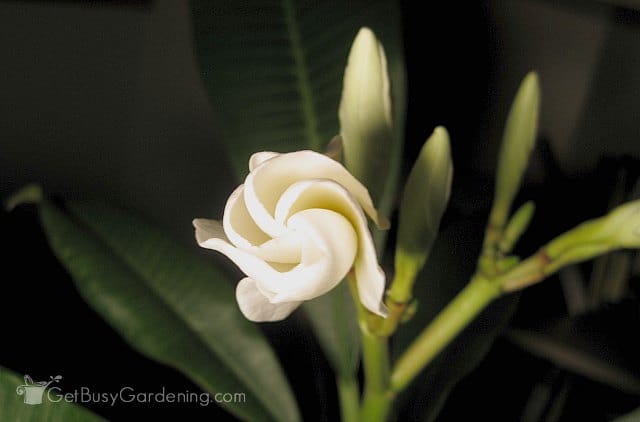
Repotting
With the proper care, frangipani trees can grow very rapidly, and may need repotting every 1-2 years.
When roots begin to come out of the drainage holes, or growth slows, it’s a sign they need to be sized up.
In the spring, move them into a container 2-4” larger than the current one. Replant it at the same depth, and expect some leaf drop or drooping as they recover.
If you want to limit their size, simply refresh the top few inches of soil and trim away some of the roots.
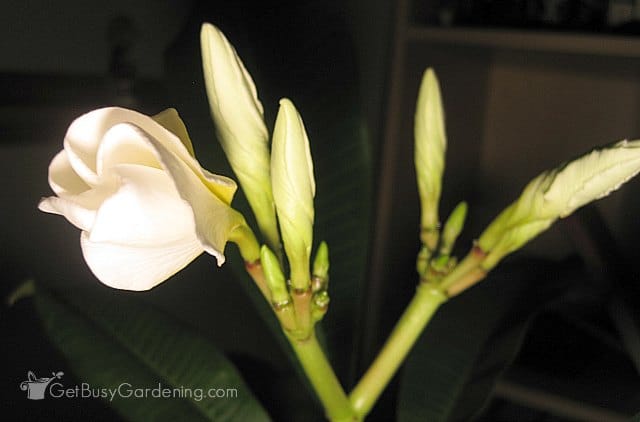
Tips For Controlling Plumeria Pests
Though pests aren’t usually an issue outdoors, plumerias can have problems with spider mites and whiteflies indoors.
If yours gets attacked by bugs, begin treating it right away. I recommend using neem oil, which is a natural pesticide that works great.
Organic insecticidal soap is also a good option. I sometimes make my own by mixing 1 tsp mild liquid soap per 1 liter of water.
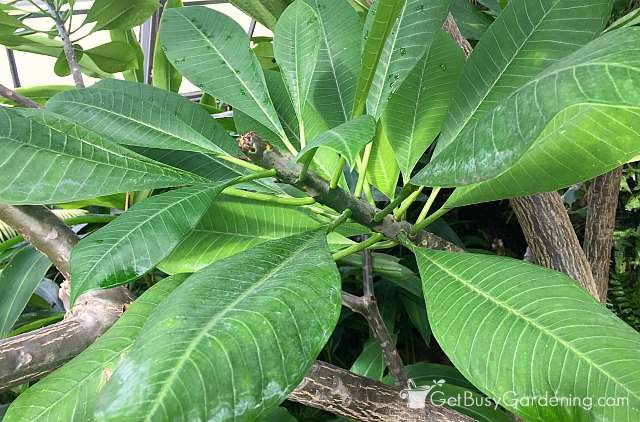
Pruning
Plumeria plants benefit from regular pruning as a part of their care routine. They can handle being trimmed back pretty severely, but never cut them all the way down to the ground.
The best time to do it is in the spring, or right after they’re done blooming.
Use sterile and sharp pruning shears so you get a nice clean cut. For thicker branches, you may need to use a lopper. Also, wear eye protection and gloves to protect against the sap.
Always make your cuts at a downward angle, so water can’t settle into the wound and cause the branch to rot.
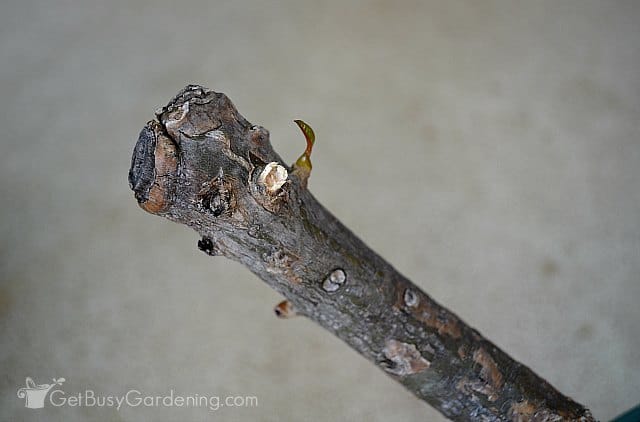
Plumeria Propagation Tips
Though they can be grown from seed, most home gardeners propagate their plumeria by taking cuttings.
It’s pretty easy to do. Simply take a section from a healthy branch, remove the flowers and leaves, and allow it to cure for several days.
Dip the cut end in rooting hormone, then place it into a slightly moist medium. Keep it in a warm spot until you see new growth on top. Get my step-by-step tutorial for how to propagate the cuttings here.
Plumeria Winter Care & Dormancy
Once the temperature starts to cool in the fall, and there’s less sunlight, your plumeria will start to go dormant naturally. This is the time to stop fertilizing, and slow down on watering.
The leaves will turn yellow and then brown before finally dropping off. This is totally normal, so don’t panic. It might not drop all of the leaves though, and that’s ok too.
If you live in a cold climate, this makes is much easier to overwinter them indoors. So there’s no need for artificial lights or a sunny window.
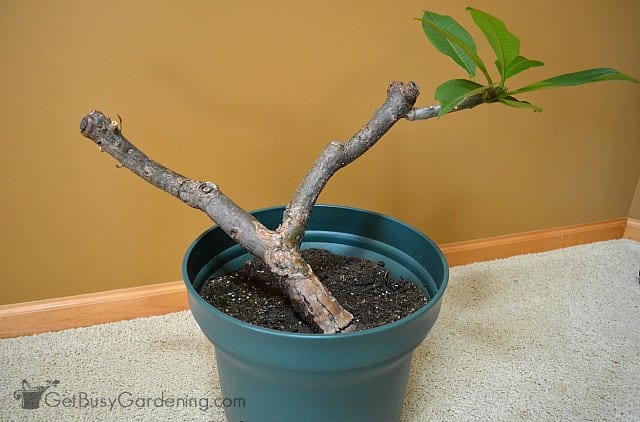
Troubleshooting Common Plumeria Care Problems
Though plumeria are fairly simple to care for, they are notorious for having a few problems. Below I’ll help you troubleshoot and fix the most common issues.
Tip Rot
In my experience, tip rot is a pretty common problem. It happens when water settles in a crack or wound on the end of a branch, which is usually caused by improper pruning or frost damage.
If left untreated, the rot will spread, and could eventually kill the plant. You can save it by cutting off all of the rotted pieces of the affected branch.
Stem Rot
If the stem is mushy and rotting at the base, then you have a more serious problem. Stem rot is caused by overwatering.
If left untreated, your plant will die for sure. If the rot isn’t too severe, you can save it by taking cuttings of the healthy stems or branches and rooting them.
Plumeria Won’t Bloom
This is probably the #1 question I get asked about growing plumerias, and there is one simple answer… fertilizer.
They need fertilizer in order to bloom, and lots of it. The good news is that it’s such an easy fix. Once you get the hang of it, they will flower profusely for you.
Leaves Falling Off / Dropping
Leaf drop can be caused by a lack of water or cold temperatures. It’s natural for them to go dormant during the winter when it gets below 50°F, and this is nothing to worry about.
However, if it happens during the summer, then check to make sure they’re getting enough water. They should never dry out completely. Also inspect the branches and trunk for signs of rot.
Leaves Turning Yellow
Yellow leaves are also a sign that they’re starting to go dormant, however it could be from overwatering, pests, or disease.
Check the soil to make sure it’s not wet or soggy, inspect the leaves for bugs, and verify that the stems are firm and not rotting.
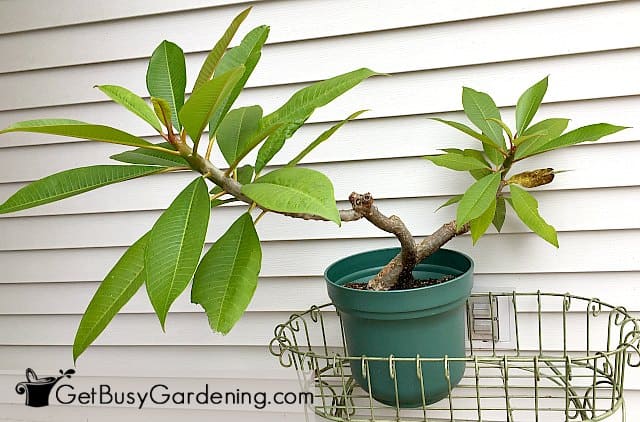
FAQs
In this section I’ve answered some of the most frequently asked questions about plumeria care. If yours isn’t listed, please ask in the comments below.
Are plumeria hard to care for?
No, plumeria are not hard to care for. They’re actually quite easy to grow, as long as you understand their requirements.
How long does it take for a plumeria to be full grown?
How long it takes for a plumeria to be full grown totally depends on the variety. Some grow must faster than others, though on average they can put on 12-36″ per year with the proper care.
Is plumeria an indoor or outdoor plant?
Plumeria can be either an indoor or outdoor plant, depending on where you live. They’re only hardy in the warmest regions, so people in cold climates must bring them indoors during winter.
Is plumeria a succulent?
No, technically plumeria is not a succulent, they are tropical plants. Though they do have some similar care requirements and properties.
Is frangipani the same as plumeria?
Yes, frangipani is the same plant as plumeria. Frangipani is the common name for them. Plumeria is technically the scientific name, though many people also call them that since it’s easier to pronounce.
Plumerias are wonderful plants that are surprisingly easy to care for. Once you know the tricks for growing them, you’ll be able to keep yours thriving for decades to come.
If you want to learn all there is to know about maintaining healthy indoor plants, then you need my Houseplant Care eBook. It will show you everything you need to know about how to keep every plant in your home thriving. Download your copy now!
More Houseplant Care Guides
- How To Grow Begonia Plants
- Wandering Jew Plant Care & Growing Guide
- African Milk Tree: How To Grow & Care For A Euphorbia trigona Plant
Share your plumeria plant care and growing tips in the comments section below.


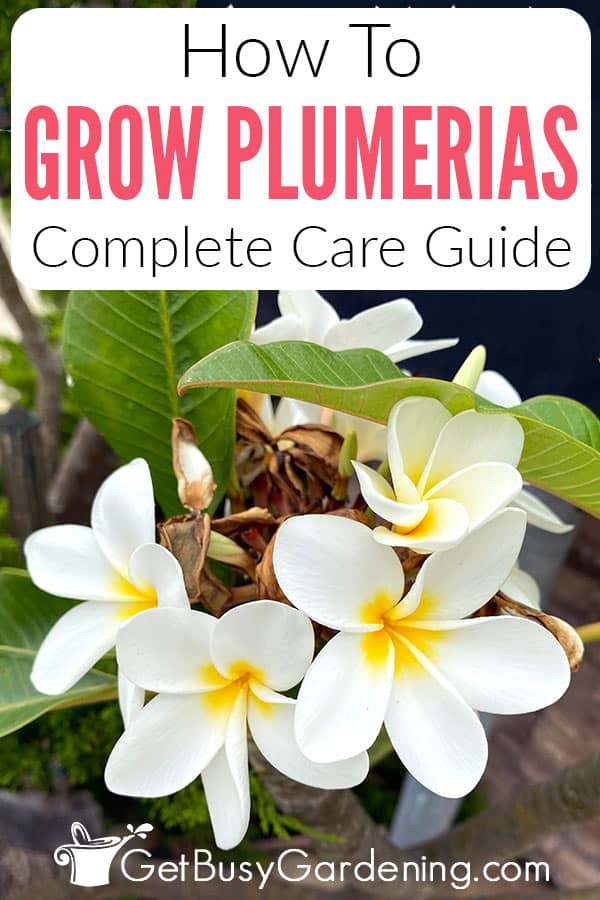
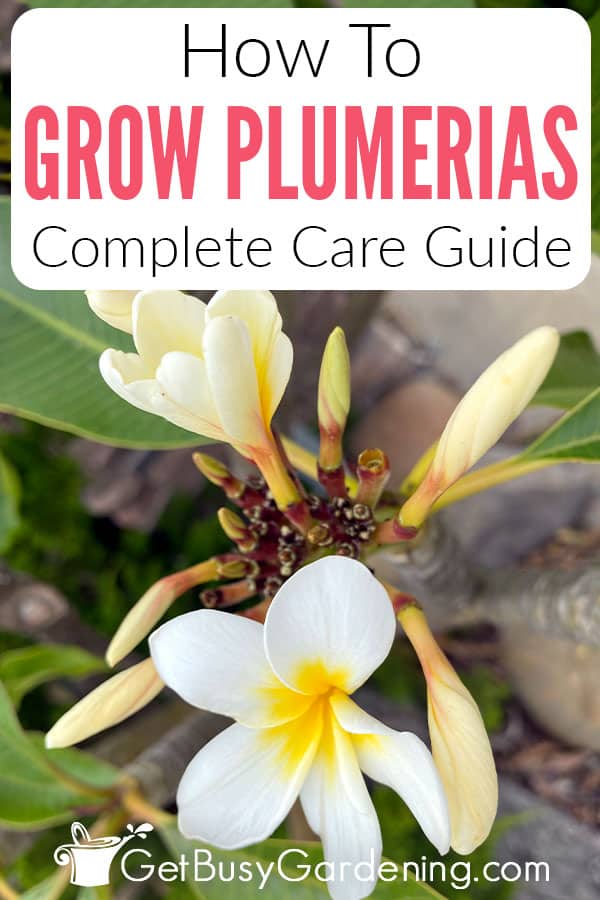
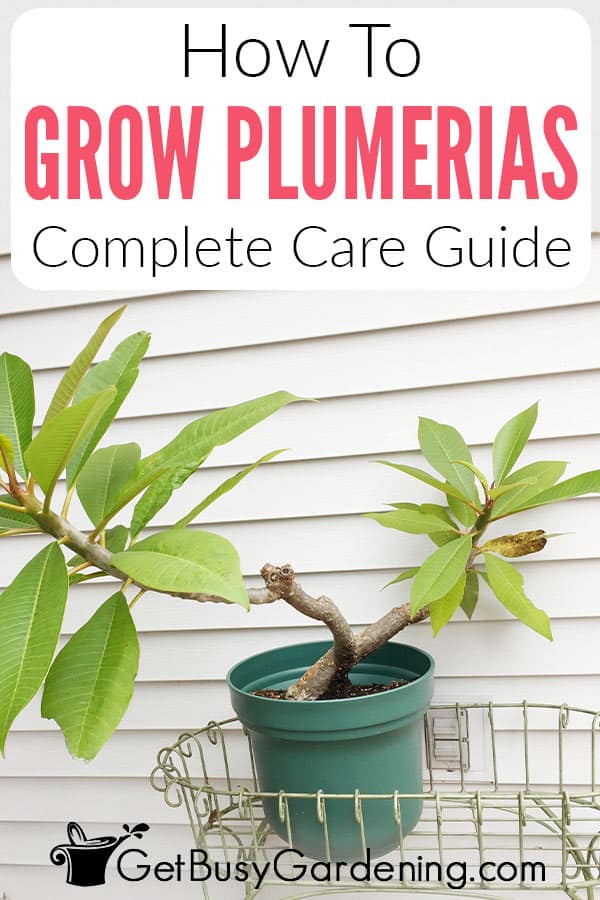
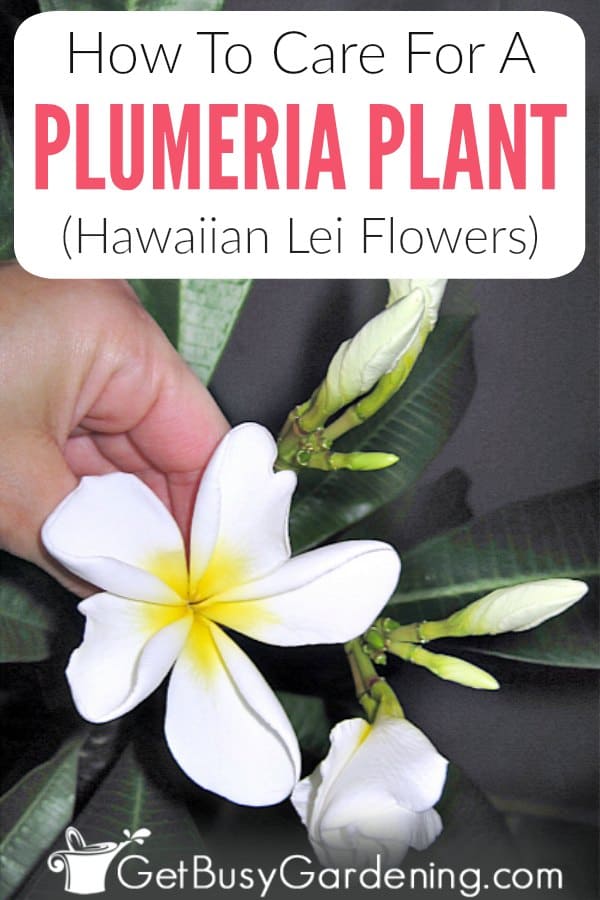



RV says
I live in Southern California, I bought and planted 2 Plumeria trees this summer and they seemed to being doing fine. Over the last month, when the weather cooled off I noticed the leaves turn yellow then brown and falling off. Are they entering dormancy? Are they getting too much water? Rust? After reading your article I feel like they entering dormancy but just a little worried. Thanks
Amy Andrychowicz says
Yes, it sounds to me like your plumeria plants are going dormant for the winter. As long as the stems and trunk are firm, then there’s nothing to worry about. Let the soil dry out during dormancy, and then start watering again in later winter/early spring to help wake them up.
Chris Nicholl says
I live in Michigan and have kept my Plumeria alive for 3 years. I brought it inside this fall and it has buds. Should I continue to water until it blooms? Also some leaves have black tips and holes ? Treatment
Amy Andrychowicz says
Oh how exciting! Definitely move your plumeria to a sunny location so it will continue to bloom. You can slow down a bit on watering since it’s inside. But don’t let it dry out completely. I suspect the brown leaf tips mean the plant was touched by frost, or it got too cold. The leaves will probably eventually fall off, which is normal during winter. Good luck, I hope it will flower for you!
Billie Sharpe says
I live in south Mississippi and mine are planted in the ground and is about 5′ tall . Do I need to dig it up and if so do I put it back in a pot or do I just leave it out ?
Amy Andrychowicz says
Plumerias are hardy down to zone 10. So, if you’re in zone 10 or higher, then you can keep them in your garden year round. Otherwise, you should definitely bring it indoors for winter.
Barbara Churchill-Shindler says
Okay I tried to find the answer above, but not good at comprehension, so my plumeria is getting very big, but I want to keep it in it’s pot, and just cut it back. How do I do this and when? I live in the Central Texas gulf coast.
Amy Andrychowicz says
No problem. Read the “How To Prune Plumeria Plants” section above for pruning tips. 🙂
Susan Thomas says
I have 3 large plumeria. Two I pruned this spring, all of them I repotted. Unfortunately no blooms this year (I wasn’t diligent with fertilizing and was using the wrong kind for a while. I used regular miracle grow most of the summer then figured out it should be the bloom booster). I live in Eastern Pennsylvania and had to bring them inside because of lowering temps. Usually I put them in my basement and forget them till Spring, however, I was thinking of putting them in my southeastern family room that has lots of windows and gets a lot of sun because the thought of my husband carrying these “trees” downstairs frightens me! Do you think they will stay leafed out, and possibly bloom over the winter? Last year I had one that bloomed in the basement till February, lol!.
Amy Andrychowicz says
Yes, that’s definitely a possibility. My plumeria bloomed in my basement in December one year. 🙂 Enjoy!
Carol Harris says
I recently brought home a plumeria plant from California that belonged to my daughter. I live in Colorado. How do I know when to let the plant go dormant for the winter? Also, just to be sure, I don’t water it at all during the winter? Just check for bugs?
Thanks!
Amy Andrychowicz says
Once you bring it indoors, you should stop watering. With the cooler temps and less daylight in the fall, in addition to getting less water, your plumeria will naturally go dormant. I do not water mine all winter. BUT, mine is a large, well established plant. If yours is a small start, then I would water it a couple of times throughout the winter. Just make sure the soil is completely dry before adding more water, so you don’t accidentally give it too much. Good luck!
Karen says
Thank you for this informative article. My plumeria keeps folding over. Do they typically need to be staked? Is this a sign that my pot is too small?
Amy Andrychowicz says
No, you should not have to stake your plumeria. When you say your plumeria keeps “folding over”, does that mean that the stem is collapsing? If that’s the case, then you should check to make sure it’s not rotting. If the stem is soft and mushy, then it’s rotting. The only way to save it is to cut off all the rot, and/or root the cuttings. Learn how to propagate plumeria cuttings here.
Dennis Axberg says
I have potted a plumeria cutting and have mistakenly over watered it. It has produce several leaves and even has a flower stalk coming out with several buds. The base is firm and the top few inches with all of the leaves is firm. The scary part is about 2/3 of the stem is leathery looking and soft but not mushy. I have started watering it only once a week and checking the soil before watering. Is there any hing else to do or is this one not likely to recover?
Amy Andrychowicz says
Usually when the stem is soft, that means it’s either starting to rot, or it’s not getting enough water. During the summer, plumeria cuttings can handle a lot more water than they can in the winter. So I would just hold off on watering your cutting until the soil has dried, then give it a good deep drink. Then all you can really do is monitor it to make sure the stem doesn’t get mushy (and keep your fingers crossed!). Good luck!
Laura Bennet says
Our plumeria is growing like crazy this year. We live in Southwest Florida and got the plant from a friend’s cuttings. This may sound strange, but I started dumping my juicing pulp (kale, lemon, cucumber & apple) in the container thinking it might be a good use of the pulp since I hate to throw it out. I did this once every couple of weeks or so for a few months this winter and early spring. Apparently our plant loved it because it’s super healthy with full foliage and huge clumps of flowers. Our problem is that I never knew we were supposed to prune it and now it’s about 6 ft tall by 4 ft wide growing in a pot that is way too small and starting to tip over. We’re not sure how big of a pot we need to transplant it to, or if we should prune it after this bloom is done and grow the cuttings. Open to any suggestions.
Amy Andrychowicz says
Wow, wonderful use of a natural fertilizer for your plumeria! Thanks for sharing. You can either prune back your plant to keep it small, pot it up into a larger container, or a combo of both. If you don’t want it to get much larger, you could pull it out of the current pot, and trim off some of the outermost roots (don’t cut off any largest roots), then put it back into the same pot. That will help keep it smaller. Here’s a detailed post about repotting plants that shows that technique.
As for rooting the cuttings, here are step by step instructions for how to do that… How To Propagate Plumeria From Cuttings. Have fun!
Christine Bauer says
I live in central Florida and the plumeria love it here. My cousin have me a couple starts last year and told me how to root them. I wasn’t able to prepare a bed right away so I put them in a bucket with water, just till I could get them planted. Here we are 9 months later and amazingly they rooted in the water and even had a couple of leaves come spring. I finally got them in the ground a month ago and they are thriving in spite of my ignorance. Thanks for the great article, my plumeria thank you too!
Amy Andrychowicz says
LOL! It’s funny because plumerias look so delicate and high maintenance… but they actually thrive on neglect. Thanks for sharing your story about rooting them in water. I haven’t tried that before, but now you’ve got me wanting to experiment!
Susan Thomas says
Hi, I have 3 plants that are about 4 ft high. I let them go dormant in the winter and when the nights start to be above 50 degrees I put them on my south facing deck. Last week I repotted my plants into bigger pots and made a few cuttings. All 3 have 2 branches, like a Y. On one plant I just cut one branch, and on one of them I cut back pretty hard, lopping of both stems about 6 inches above the “Y split”. I made the cuts on an angle to prevent rotting like I read above. I just hope I didn’t kill it!
How long until it leafs out where I made the cuts?
Amy Andrychowicz says
Sounds like you pruned your plumeria correctly. It could take a few weeks before you start to see new growth, even as long as a month if your plant hasn’t broken dormancy yet.
Susan says
Thank you for your encouragement ! Feeling much better! ?
Amy Andrychowicz says
You’re welcome!
Kerry Gwydir says
I live in NY, but frequent Hawaii and southern California every year. With my Hawaiian tastes comes my love of plumeria. My wife and I took a cutting from a plumeria tree in SoCal three years ago and have had some success growing it and also getting some leaves (no flowers yet). We treat it very delicately — always in a warm space, never outside unless it’s over 70 and sunny, etc and we rarely water it. Until recently, it was doing fine and losing leaves sporadically. However, my wife was repotting other plants and thought fresh potting soli would help its growth and, instead, the leaves turned yellow, curled up and eventually fell off. My question is whether is is normal behavior after a repotting (which we’ve done twice before without these types of effects) and if you have any suggestions, moving forward.
Amy Andrychowicz says
I’ve never had that happen after repotting my plumeria either, and I’ve repotted it several times. It sounds to me like repotting it may have triggered dormancy. It may have been too early to repot it, especially if it didn’t drop it’s leaves over the winter. As long as the stem is still firm, and not mushy, then your plumeria is just dormant. I would treat it as you normally do in the spring when it’s coming out of dormancy, and hopefully it will wake up again.
Susan says
Our plumeria won’t branch out and it hasn’t bloomed. I see from your advice we need to fertilize more than we have if we want blooms, but how do we get it to branch out. Right now it’s about 2 1/2 feet tall with lots of big, green leaves, but no blooms or interesting branch structure. To say the least, it’s fairly boring. Help!
Amy Andrychowicz says
Oh no, sorry to hear that you plumeria is boring, LOL! You have to prune them in order for them to branch out. Once you snip off the tip, it will callus over, and then branch out just below the cut. Make sure you make the cut at a downward angle though, to keep water form pooling and rotting the stem. See the section in the article above titled “How To Prune Plumeria Plant”. Spring is the best time to prune them, and you can try rooting the cutting to grow a new plant if you want.
Kriss says
Plumeria branch out after they bloom. You don’t have to prune them to get them to branch out. You do have to use fertilizer to get them bloom first and then you will see how they start to branch out from where the bloom was. They can develop seed pods after they bloom too, and it is kind of cool to watch the pods grow and open up.
Sherry says
potted outdoor Plumeria tree. I want to trim the flower stem off but have not found anywhere if I should?
Amy Andrychowicz says
Take a look at the pruning section in the article above for details, here’s a direct link… How to prune plumeria plants.
Marshall wages says
I have two plumerias in one pot, the roots have grown together. If I cut the rootball into in the winter when they are dormant will it kill them.
Amy Andrychowicz says
If you want to divide the two plumerias, then I would recommend waiting until they start to regrow in the spring, rather than doing it during the winter while they are dormant.
Laura Mauldin says
Thank you so much for the wonderful advice. I live in Alabama and always wondered if I could get one to grow. You have inspired me to try.
Amy Andrychowicz says
You’re welcome! Yes, if I can do it here in MN, you would definitely be able to grow plumeria in Alabama! 😉